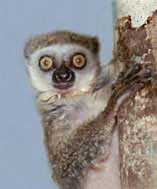The name of this family is usually spelled Indriidae; here, we follow Wilson and Reeder (1991) and sources cited therein in the spelling Indridae, and in using using the generic name Avahi rather than Lichanotus.
Indridae
indrisoids, avahis, sifakas, indris
This small family of 3 genera and 5 species is restricted to Madagascar. Despite relatively few species, the Indridae are a diverse lot, ranging in body length from only about 300 mm in body length (excluding the tail) to almost a meter, and from around 1 kg weight to 10 kg (the largest strepsirhine). The tails of sifakis and avahis (Propithecus and Avahi) are relatively long, while that of indris (Indri) is merely a stump. The face of sifakis and avahis is much shortened compared to lemurs, while that of the indri is nearly as long. The external ears of indrids are small and buried in their fur. The pelage ranges in texture among species from woolly to silky, and coloration varies considerably.
All species are vertical clingers and leapers. Their hind limbs are about 1/3 longer than their forelimbs; their hands are long, slender, and strong; and they have nails on all digits of their forelimbs. Their hind feet are very large but also narrow, and their hallux is well developed and opposable. Hind toes 2-5 are connected at the base by a web of skin, which causes them to be used as a unit against the hallux. Indrids have a curious fold of skin that runs from their chests to their arms, which may represent a vestigial gliding membrane.
Indrids have a globular braincase. The bullae overgrows and incorporates the tympanic ring. The two dentaries are joined by a long and oblique symphysis, and each is characterized by an enlarged angular process. Their dental formula is 2/1, 1/1, 2/2, 3/3 = 30, and the toothcomb includes 4 lower teeth (incisors and canines) rather than the usual 6 of most strepsirhines. The upper incisors are enlarged, the upper canine is elongate, and the first lower premolar is canine-like.
Indrids are strict vegetarians. They feed on leaves, fruits, bark, and flowers. Their stomachs are simple but large, their intestinal tracts are unusually long (in part due to an elongated caecum), and they have especially well developed salivary glands (apparently an adaptation to feeding on leaves, also seen in leaf-eating cercopithecid monkeys).
Avahis are nocturnal, sifakis and indris are diurnal. Avahis and indris are found usually in smaller groups of 2-5; sifakis often congregate in larger groups of around 10 individuals. Groups of indris communicate with mournful and distinctive howls. Scent marking and facial expressions are also important to these species.
The fossil record of indrids extends only to the Pleistocene.
HOME
Primates
Primate FAQ
Indri Pictures
Sifaka Pictures
Primate Species
Search Primates.com
Primates E-Mail Service
